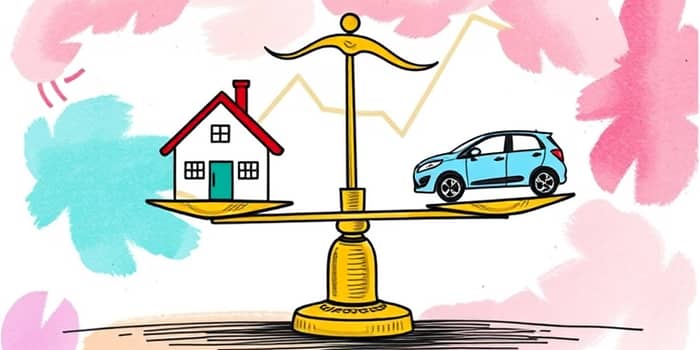Secured loans can open doors to major purchases or debt consolidation by using your assets as leverage. Understanding how collateral works and the risks involved empowers you to borrow responsibly and protect what matters most.
What Defines a Secured Loan?
At its core, a secured loan requires you to pledge an asset as collateral in exchange for funds. This collateral can range from a home or vehicle to a savings account or investment portfolio.
When you offer collateral, the lender gains assurance that if you default, they can sell the pledged asset to recover their losses. This structure often results in lower interest rates than unsecured loans and access to higher borrowing limits tied directly to the collateral’s value.
How Secured Loans Work
Secured loans follow a structured process designed to balance opportunity and protection. Here are the key stages:
- Application: Submit personal, income, and asset details to the lender
- Valuation: The lender appraises or verifies the market value of your collateral
- Lien Placement: A legal claim is placed on the asset until the loan is repaid
- Disbursement: Once approved, funds are released under agreed terms
- Repayment: You make scheduled payments of principal and interest over the loan term
Terms can vary widely—from one-year personal loans to 30-year mortgages—depending on the purpose and collateral type. Because the lender’s risk is mitigated, you often benefit from competitive rates and more flexible eligibility requirements.
Types of Secured Loans
Secured financing comes in several forms, each tailored to different needs and assets. Choose the option that aligns with your goals and collateral availability.
For example, using home equity can fund renovations or consolidate higher-rate debts, while a secured credit card helps build or restore credit with a refundable deposit.
Secured vs. Unsecured Loans
A clear distinction exists between secured and unsecured loans. Unsecured options rely solely on your creditworthiness, with no asset backing.
Secured loans typically feature:
- Lower interest rates because collateral reduces lender risk.
- Higher borrowing limits, often up to 80–100% of the asset’s appraised value.
By contrast, unsecured loans often demand strong credit, charge higher interest rates, and carry penalties such as credit damage or legal action if you default.
Pros and Cons of Secured Loans
Deciding whether a secured loan suits your needs involves weighing tangible benefits against potential pitfalls.
- Easier approval for borrowers with limited credit history
- Access to larger sums based on your collateral
- on-time payments help build credit and improve borrowing power
- Competitive rates and flexible terms
However, defaulting carries serious consequences: the lender can enact the lien and seize and sell your collateral. This loss can be financially devastating and emotionally taxing, especially when the asset holds personal significance.
Additionally, securing your loan often means undergoing appraisals, legal reviews, and potential insurance requirements, which may extend approval timelines and incur extra costs.
Key Considerations Before You Apply
To navigate secured loans confidently, thoroughly evaluate your financial goals and your ability to maintain consistent payments. Reflect on these critical questions:
- What is your loan-to-value ratio and market value for the proposed collateral?
- Can you comfortably cover monthly payments along with existing obligations?
- Are there prepayment penalties, origination fees, or other hidden costs?
- What consumer protections apply to foreclosure or repossession in your jurisdiction?
Comparing multiple lenders and loan products helps you secure the best terms. Always review the fine print, and consider seeking advice from a financial professional.
Practical Tips for Responsible Borrowing
Secured loans can be powerful tools when managed wisely. Start by creating a detailed budget that prioritizes debt obligations and allocates funds for an emergency savings cushion.
Set up automatic payments or calendar reminders to avoid late fees and protect your credit. If you face unexpected hardships, communicate early with your lender—options like forbearance or modified repayment plans may be available to help you stay on track.
Conclusion
A secured loan can unlock significant financial opportunities, from purchasing property to consolidating debt at a lower cost. By requiring collateral, lenders reduce their exposure, which translates into lower interest rates than unsecured loans and greater access to funds.
Yet the promise of lower rates comes with the weighty responsibility of safeguarding your assets. Understanding the process, comparing offers, and planning for every scenario will help you harness the benefits while minimizing risks.
When approached with caution and preparation, secured loans become gateways to achieving life’s milestones—whether owning a home, financing a dream car, or building a stronger credit profile. Borrow with clarity, protect your assets, and use these financial tools to empower your future.
References
- https://www.investopedia.com/secured-loans-5076025
- https://www.lendingtree.com/personal/how-do-collateral-loans-work/
- https://www.equifax.com/personal/education/personal-finance/articles/-/learn/what-is-a-secured-loan/
- https://www.ne.bank/secured-vs-unsecured-lending
- https://www.bankrate.com/loans/personal-loans/what-is-a-secured-loan/
- https://www.truist.com/money-mindset/principles/outsmarting-debt/secured-vs-unsecured-loans
- https://www.nerdwallet.com/article/loans/personal-loans/what-is-a-secured-loan
- https://www.pnc.com/insights/personal-finance/borrow/secured-vs-unsecured-loans.html










